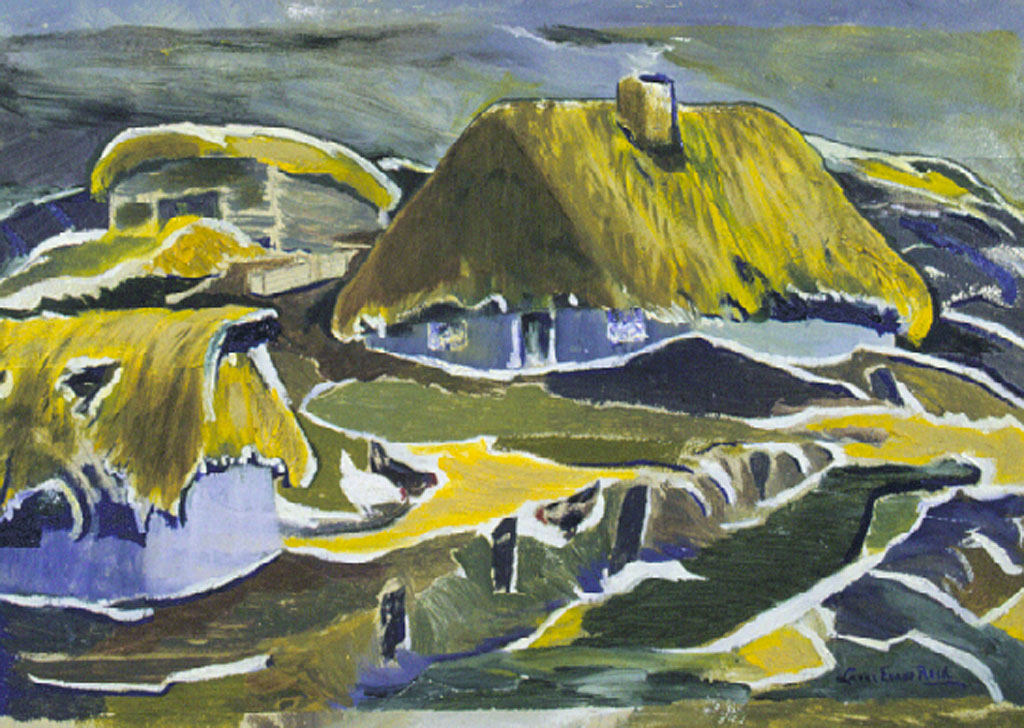Art in Focus: “Early Ukrainian Home in Alberta” by Laura Evans Reid

"Early Ukrainian Home in Alberta," 1948; Painting; oil on hardboard; Laura Evans Reid: Born 1883, Guelph, Ontario, Died 1951, Vegreville, Alberta; University of Alberta Museums, University of Alberta Museums Art Collection; 1975.18.9
In much of her artistic career, English-Canadian artist Laura Evans Reid focussed on Alberta’s contrasting landscape. From the Rockies to farmland and grain elevators, her paintings and sketches depict the early period of the province. These images showed not only how European settlement changed prairie landscapes, but also provided a look into the people who toiled on the land. Early Ukrainian Home in Alberta (1975.18.9) is one such painting by the artist.
With straw thatched roofs, the painting shows a house, granary, and feed structure, which show the architectural features of Ukrainian homesteads on the Prairies. Some of these early Ukrainian-built structures were made of sod and straw, and were either of burdei or zemlianka construction. The primary difference between the two types of buildings was that the burdei were located near the edge of a wooded area and made almost entirely of sod with a thatched roof, whereas the zemlianka was built on a slope with a dugout floor used for long-term food storage.1 Both types of structures were essential to life on the Prairies for early Ukrainian settlers.2
As a result of limited formal places for art education in Alberta during the 1920s and 1930s, Laura Evans Reid began her career as an artist at the age of 52. Intrigued by the opportunity to paint with a group of amateur artists at the home of a school teacher in Vegreville, Reid recalled that prior to this experience she had, “never held a paint brush or watched anyone paint.”3 As she was also the wife of a regional doctor, Reid was able to accompany her spouse during his visits to patients across central Alberta and while doing so, she also recorded aspects of daily life in sketches and small paintings. Soon after working with the local amateur art group, Reid began to take classes with artist H.G. Glyde through the University of Alberta’s Department of Extension.4 She would later go on to showcase her work in exhibitions in Toronto, Ottawa, and Calgary.
While her work can be found in many private collections in Canada, Laura Evans Reid is most known in Alberta. Long regarded as an amateur painter, Reid's work brings attention to a number of issues: how artists are trained, the role of women artists and how social standing plays into one's success. Though she had established herself as a milliner in Toronto, Reid saw herself (which was also reinforced by the press at the time) as “the responsible wife of the doctor, who took time off to paint.”5 Such complexities add to the social and cultural understanding of Reid’s work.
The University of Alberta Museums Art Collection holds approximately 100 paintings and drawings by Laura Evans Reid. Many of these works were donated to the University by the artist’s estate and they represent one of the largest bodies of work of a single artist in the Art Collection. Though largely focused on landscapes and interior scenes, Laura Evans Reid’s work and life also provides a glimpse into Alberta’s not-too-distanced past.
1“The Ukrainian Dugout Home,” https://www.collectionscanada.gc.ca/eppp-archive/100/200/301/ic/can_digital_collections/pasttopresent/rural_life/ukr_dugout_home.html, accessed 13 July 2022.
2 Another example of built-forms by early Ukrainian settlers include the Pioneer Home at Elk Island National Park: https://www.pc.gc.ca/apps/dfhd/page_fhbro_eng.aspx?id=6048.
3 Laura Reid Evans, Letter to Miss Sims, 9 July 1945, Laura Evans Reid Fonds, Archives of University of Alberta.
4 Chown, Diana. Laura Evans Reid: 1883-1951 (Edmonton, AB: University Collections, University of Alberta, 1983),18.
5 Ibid.,14.
This web story is part of the University of Alberta Museums Art Collection Spotlight Series, a collection of web stories aimed to share works of art from the University of Alberta Museums Art Collection with the world. Posted monthly, these stories connect works of art in the Collection to important matters on our campus and in our world.